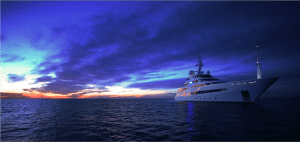MTN Releases New Connectivity Solution for Yachts
[Via Satellite 05-15-2014] MTN Communications has released a new maritime solution aimed at the yachting industry. The solution, called Maestro, improves bandwidth efficiency by approximately 40 percent, according to a case study conducted by MTN, and pools together Very-Small-Aperture Terminal (VSAT) connectivity with 4G, Wi-Fi, Mobile Satellite Services (MSS) and others.
“The yachting industry, which has been a luxury go-lucky industry, became very mature overnight,” Derik Wagner, MTN’s managing director of yacht business services, told Via Satellite. “Yachts became bigger and things became much more serious, [including] communications … The job of driving a vessel for many captains became more than just piloting that vessel.”
With the yachting industry powered by high-wealth individuals, the demand for connectivity outpaced other maritime sectors. Wagner added that it is not uncommon for yacht owners and guests to bring at least two electronic devices requiring connectivity onboard. Additionally, more than 80 percent of vacationers plan to stay connected, and 52 percent plan to work, up from 46 percent in 2011, according to the May 2012 American Express “Spending and Saving Tracker Report.”
“Given the complexity of requirements on yachts today, bandwidth has to be optimized to address those requirements,” AJ Anderson, founder and owner of Wright Marine Group (WMG) said in a statement. “Managers and vessel crew need a clear method to pre-plan and manage with no uncertainties related to performance.”
The trend toward greater connectivity is only projected to increase. According to a Cisco white paper, by 2018 mobile connected tablets will nearly double the amount of traffic on the global mobile network generated in 2013. Smartphone traffic per phone grew from 353 MB per month in 2012 to 529 MB per month in 2013. Wagner said these numbers factored heavily into the creation of Maestro. For some yachters, connectivity has become such a large factor that it is now a prerequisite for owning a vessel at all.
“[Charter and management companies] don’t want a call from an owner who says, ‘This is ridiculous — I can’t get connected to my online trading; I’m paying how much money and I can’t be on my yacht?’ Then the whole deal is off. It’s a deal-breaker and they end up selling the boat because they can’t stay connected while they are at sea. Charter and yacht management companies can’t afford to do this because it is their livelihood,” said Wagner.
MTN was also having trouble assisting yacht owners with applications beyond just their satellite connectivity. The company services more than 300 of the world’s largest yachts, and it has become a major part of its business, but it could not see and effectively assist customers out at sea.
“Throughout this whole time it became very evident to us that there was a need onboard that superseded what we were currently bringing,” said Wagner. “What we struggled with was when vessels would call in to our operations center and talk about problems they were having where they were not able to do the things they wanted to do whether it meant slow Internet, poor video streams, poor video conferencing or all of the above.”
MTN tested its new service on a medium sized yacht to determine its efficiency. Wagner said the company services yachts ranging from 30 meters to 180 meters in length. Depending on the size of the vessel and the traffic demands, different owners could see different levels of improvement in bandwidth optimization. Some could see greater than 40 percent, while others less; but regardless, the service is able to cut down on issues such as latency.
“The improvement of network performance by 40 percent is taken from a case study on a 78-meter yacht that we service,” said Wagner. “I chose this case study because I really feel the 40 percent optimization is the middle mark … it depends on the type of usage, the size of the vessel and the overall end user requirements. The 40 percent number is more the mean of what Maestro can bring.”
Maestro centralizes the ship’s communication systems, customizes per vessel and features a smaller hardware footprint. According to Wagner, previously MTN or another company would profile VSATs separately from other forms of connectivity. Legacy systems would allow customers to turn the VSAT on or off, but could not effectively switch to other methods. The company’s new service makes greater use of multiple connectivity options and makes assistance for yacht owners easier.
“It is about streamlining data, which frees up limited bandwidth so it can do more,” said Wagner. “It establishes clear Quality of Service (QoS) parameters to prioritize critical users and applications. And it enables continuous monitoring of the end-to-end network so there can be regular fine-tuning by MTN or the customer.”
